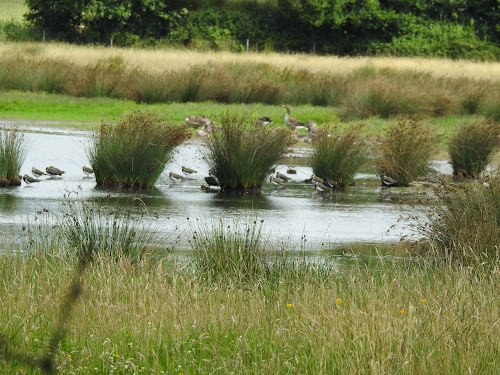Despite this I recorded a Grey Wagtail at Netherstead, and a singing Grasshopper Warbler in the field behind the beehives on the walk to the flash field.
The flash field is getting really difficult to observe properly this autumn. The one new wader present was a juvenile Little Ringed Plover on the sparsely vegetated part of the nearest flash. This area can only be seen from beneath trees towards the Kingfisher Pool, and it is increasingly difficult to see any birds which might not be in that one spot.
 |
| Little Ringed Plover (Lapwings in the foreground) |
There is a species of tall sedge (I think its Common Club-rush) which is sprouting out of the mud of the nearest flash, and seems to be increasing each year. From a birding point of view it's a bloody nuisance because it makes counting birds (particularly waders) very inaccurate. Today for example I could only see two Green Sandpipers, but they were in the area favoured by the rush. So there may well have been more I couldn't see.
 |
| The visible flash |
The traditional spot further back down the fence allowed me to see no Lapwings etc, but a Little Egret was visible, partly obscured by vegetation. However, it could not be seen at all from under the trees.
 |
| Little Egret |
Anyway, apart from chunter away on this blog there is nothing I can do about it because the flash field is privately owned and, as far as I know, it is still a part of the Natural England stewardship scheme. I am grateful that it exists at all.
The walk back around the delightfully colourful HOEF weed-rich fields led me back to Netherstead where the paddock produced a Redstart. Although, it was at the track end of the field, I think that this is the same bird as was present nine days ago. Ageing Redstarts in late summer is quite difficult. Both adults and juveniles moult before they migrate, and this extremely tatty bird was certainly moulting.
Although there is no trace of juvenile feathers on its mantle, the head (and possibly the upper breast) still looks a bit spotty. This should mean it is a moulting juvenile.
 |
| Redstart |


No comments:
Post a Comment